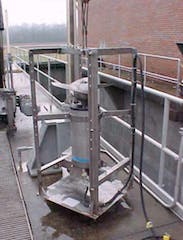The Cypress Creek wastewater treatment plant in Florence, Ala., uses an extended aeration activated sludge process with a design capacity of 20 mgd. Placed into service in 2001, the plant operates at an average daily rate of 10 to 15 mgd. A 40-acre aerated lagoon with an additional capacity of 30 mgd acts as an EQ basin, helping to address inflow and infiltration. Excess flows are contained and returned at a controlled rate to the plant for treatment.
The plant design includes bar screens and a wet pit/dry pit influent lift station with six dry-installed pumps, each with a capacity of 6,900 gpm. Fine screens, four primary clarifiers, eight extended aeration cells and five secondary clarifiers follow these. Air-mixed storage tanks feed the polymer-treated primary and secondary sludge to centrifuges.
Scope
Cypress Creek serves mostly residential customers, but about 15% of its influent comes from industrial sources, primarily a Sara Lee plant that manufactures side and sliced bacon. Despite pretreatment at the Sara Lee facility, its discharge to the Cypress Creek plant contains large amounts of fats, oils and grease (FOG).
The FOG accumulated in the wet pit of the influent lift station, forming a layer 10 ft thick or more, depending how long it was allowed to accumulate.
Once every two or three years, a crane with a clamshell bucket was brought in to remove the FOG. The FOG solids were typically so heavy and dense that the clamshell had to be dropped from the top of the crane’s boom to break through. Anywhere from 60 to 90 tons of FOG would be removed during these cleanings. Because it was untreated, the FOG had to be landfilled as hazardous waste.
The total cost for each cleaning and subsequent disposal of the accumulated FOG was approximately $100,000. Averaged over the two to three years between cleanings, the annual cleaning costs ranged from $33,000 to $50,000.
Solution
In 2005, two 15-hp Xylem Flygt SR4660 mixers were installed in the wet pit. Installation was simple and quick, as the mixers were mounted in Xylem Flygt Porta-Cleanse stands; the mixers only needed to be lowered into position on the wet pit floor. However, during the initial installation, the FOG layer was so solid that the assemblies, each weighing approximately 600 lb, could not break through. The senior plant operator was lowered in a basket with a fire hose to break through the FOG layer and allow the mixer assemblies to be lowered into place.
Result
Soon after the Flygt mixers were started, the FOG layer was observed to be breaking up. Within 6 to 8 hrs of mixer operation, the FOG layer was completely reincorporated into the influent and was being passed on into the plant for conventional treatment and removal.
Since the installation of the mixers, there has been no need for any additional cleaning of the influent wet pit. The two mixers are normally run for about 30 minutes each day, which is sufficient to keep the FOG from accumulating.
At a maximum power per mixer of 12 kW over a 365-day year, this translates to an average annual savings of more than 80%—from its original $27,500 to $44,500 to a mere $5,500. Offering reliable operation under the worst conditions, the Xylem Flygt mixers have paid for themselves many times over.



